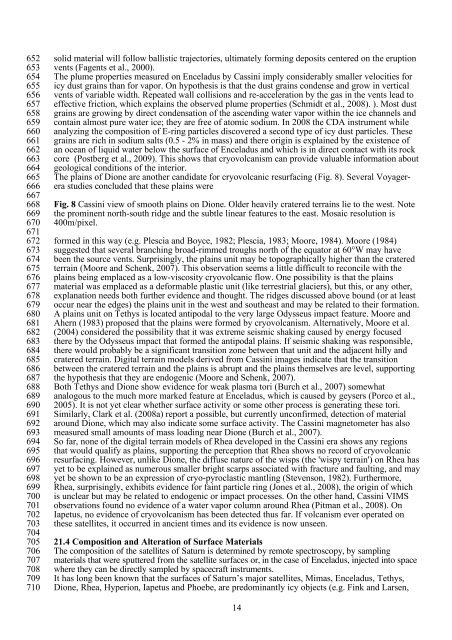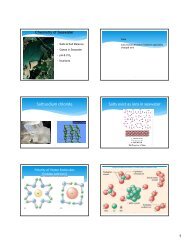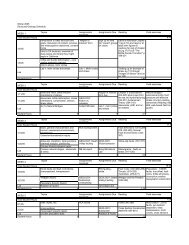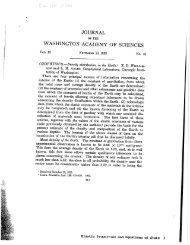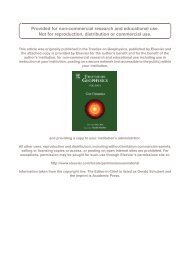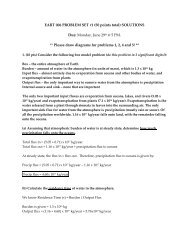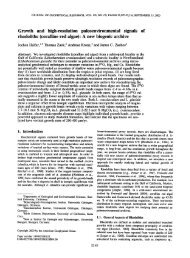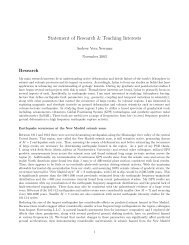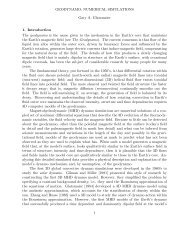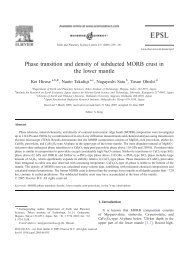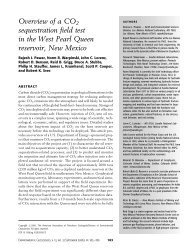Reprint - Earth & Planetary Sciences - University of California, Santa ...
Reprint - Earth & Planetary Sciences - University of California, Santa ...
Reprint - Earth & Planetary Sciences - University of California, Santa ...
Create successful ePaper yourself
Turn your PDF publications into a flip-book with our unique Google optimized e-Paper software.
652 solid material will follow ballistic trajectories, ultimately forming deposits centered on the eruption<br />
653 vents (Fagents et al., 2000).<br />
654 The plume properties measured on Enceladus by Cassini imply considerably smaller velocities for<br />
655 icy dust grains than for vapor. On hypothesis is that the dust grains condense and grow in vertical<br />
656 vents <strong>of</strong> variable width. Repeated wall collisions and re-acceleration by the gas in the vents lead to<br />
657 effective friction, which explains the observed plume properties (Schmidt et al., 2008). ). Most dust<br />
658 grains are growing by direct condensation <strong>of</strong> the ascending water vapor within the ice channels and<br />
659 contain almost pure water ice; they are free <strong>of</strong> atomic sodium. In 2008 the CDA instrument while<br />
660 analyzing the composition <strong>of</strong> E-ring particles discovered a second type <strong>of</strong> icy dust particles. These<br />
661 grains are rich in sodium salts (0.5 - 2% in mass) and there origin is explained by the existence <strong>of</strong><br />
662 an ocean <strong>of</strong> liquid water below the surface <strong>of</strong> Enceladus and which is in direct contact with its rock<br />
663 core (Postberg et al., 2009). This shows that cryovolcanism can provide valuable information about<br />
664 geological conditions <strong>of</strong> the interior.<br />
665 The plains <strong>of</strong> Dione are another candidate for cryovolcanic resurfacing (Fig. 8). Several Voyager-<br />
666<br />
667<br />
era studies concluded that these plains were<br />
668 Fig. 8 Cassini view <strong>of</strong> smooth plains on Dione. Older heavily cratered terrains lie to the west. Note<br />
669 the prominent north-south ridge and the subtle linear features to the east. Mosaic resolution is<br />
670<br />
671<br />
400m/pixel.<br />
672<br />
673<br />
formed in this way (e.g. Plescia and Boyce, 1982; Plescia, 1983; Moore, 1984). Moore (1984)<br />
suggested that several branching broad-rimmed troughs north <strong>of</strong> the equator at 60°W may have<br />
674 been the source vents. Surprisingly, the plains unit may be topographically higher than the cratered<br />
675 terrain (Moore and Schenk, 2007). This observation seems a little difficult to reconcile with the<br />
676 plains being emplaced as a low-viscosity cryovolcanic flow. One possibility is that the plains<br />
677 material was emplaced as a deformable plastic unit (like terrestrial glaciers), but this, or any other,<br />
678 explanation needs both further evidence and thought. The ridges discussed above bound (or at least<br />
679 occur near the edges) the plains unit in the west and southeast and may be related to their formation.<br />
680 A plains unit on Tethys is located antipodal to the very large Odysseus impact feature. Moore and<br />
681 Ahern (1983) proposed that the plains were formed by cryovolcanism. Alternatively, Moore et al.<br />
682 (2004) considered the possibility that it was extreme seismic shaking caused by energy focused<br />
683 there by the Odysseus impact that formed the antipodal plains. If seismic shaking was responsible,<br />
684 there would probably be a significant transition zone between that unit and the adjacent hilly and<br />
685 cratered terrain. Digital terrain models derived from Cassini images indicate that the transition<br />
686 between the cratered terrain and the plains is abrupt and the plains themselves are level, supporting<br />
687 the hypothesis that they are endogenic (Moore and Schenk, 2007).<br />
688 Both Tethys and Dione show evidence for weak plasma tori (Burch et al., 2007) somewhat<br />
689 analogous to the much more marked feature at Enceladus, which is caused by geysers (Porco et al.,<br />
690 2005). It is not yet clear whether surface activity or some other process is generating these tori.<br />
691 Similarly, Clark et al. (2008a) report a possible, but currently unconfirmed, detection <strong>of</strong> material<br />
692 around Dione, which may also indicate some surface activity. The Cassini magnetometer has also<br />
693 measured small amounts <strong>of</strong> mass loading near Dione (Burch et al., 2007).<br />
694<br />
695<br />
So far, none <strong>of</strong> the digital terrain models <strong>of</strong> Rhea developed in the Cassini era shows any regions<br />
that would qualify as plains, supporting the perception that Rhea shows no record <strong>of</strong> cryovolcanic<br />
696 resurfacing. However, unlike Dione, the diffuse nature <strong>of</strong> the wisps (the 'wispy terrain') on Rhea has<br />
697 yet to be explained as numerous smaller bright scarps associated with fracture and faulting, and may<br />
698 yet be shown to be an expression <strong>of</strong> cryo-pyroclastic mantling (Stevenson, 1982). Furthermore,<br />
699 Rhea, surprisingly, exhibits evidence for faint particle ring (Jones et al., 2008), the origin <strong>of</strong> which<br />
700 is unclear but may be related to endogenic or impact processes. On the other hand, Cassini VIMS<br />
701 observations found no evidence <strong>of</strong> a water vapor column around Rhea (Pitman et al., 2008). On<br />
702 Iapetus, no evidence <strong>of</strong> cryovolcanism has been detected thus far. If volcanism ever operated on<br />
703<br />
704<br />
these satellites, it occurred in ancient times and its evidence is now unseen.<br />
705 21.4 Composition and Alteration <strong>of</strong> Surface Materials<br />
706 The composition <strong>of</strong> the satellites <strong>of</strong> Saturn is determined by remote spectroscopy, by sampling<br />
707 materials that were sputtered from the satellite surfaces or, in the case <strong>of</strong> Enceladus, injected into space<br />
708 where they can be directly sampled by spacecraft instruments.<br />
709 It has long been known that the surfaces <strong>of</strong> Saturn’s major satellites, Mimas, Enceladus, Tethys,<br />
710<br />
Dione, Rhea, Hyperion, Iapetus and Phoebe, are predominantly icy objects (e.g. Fink and Larsen,<br />
14


